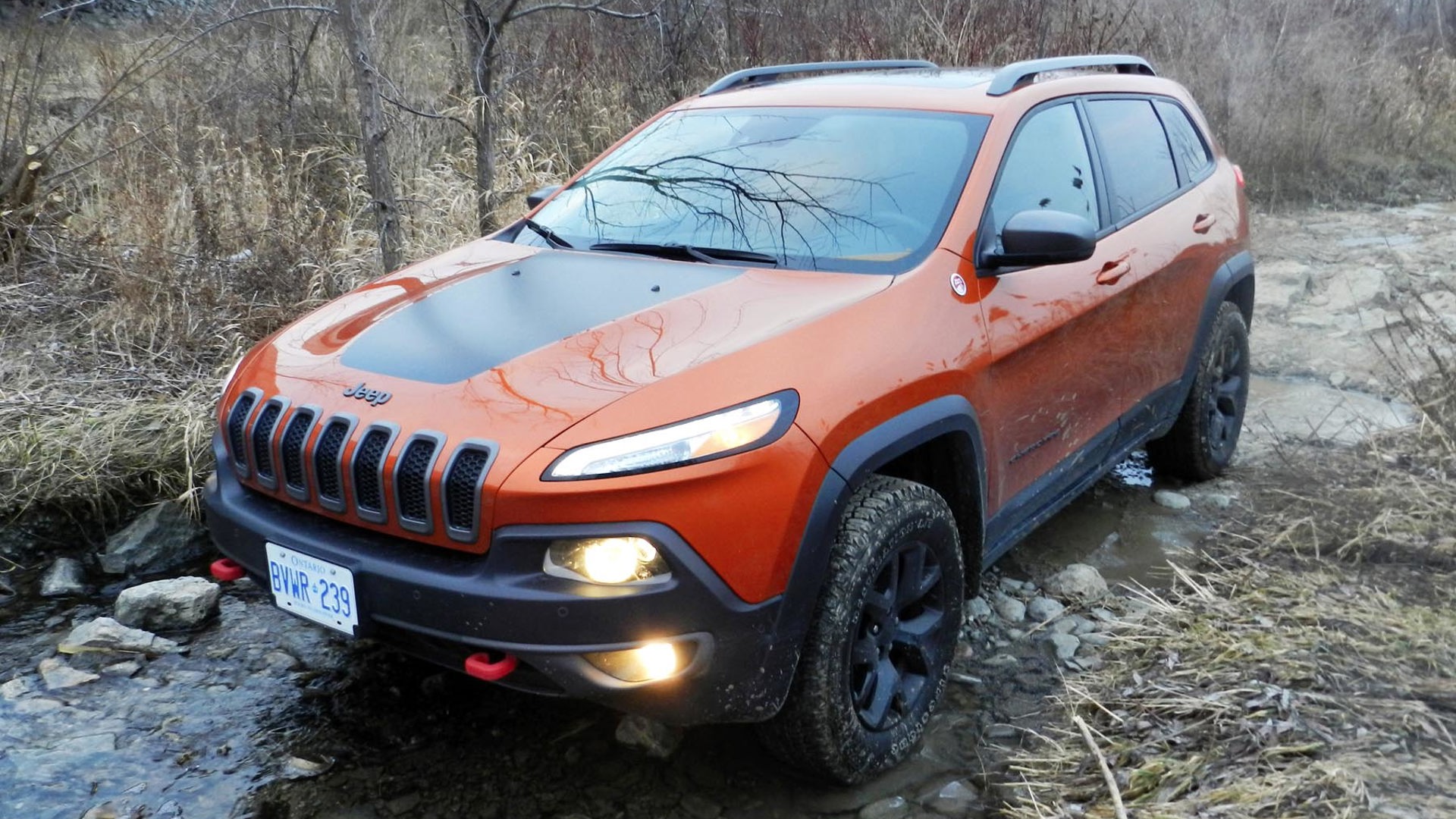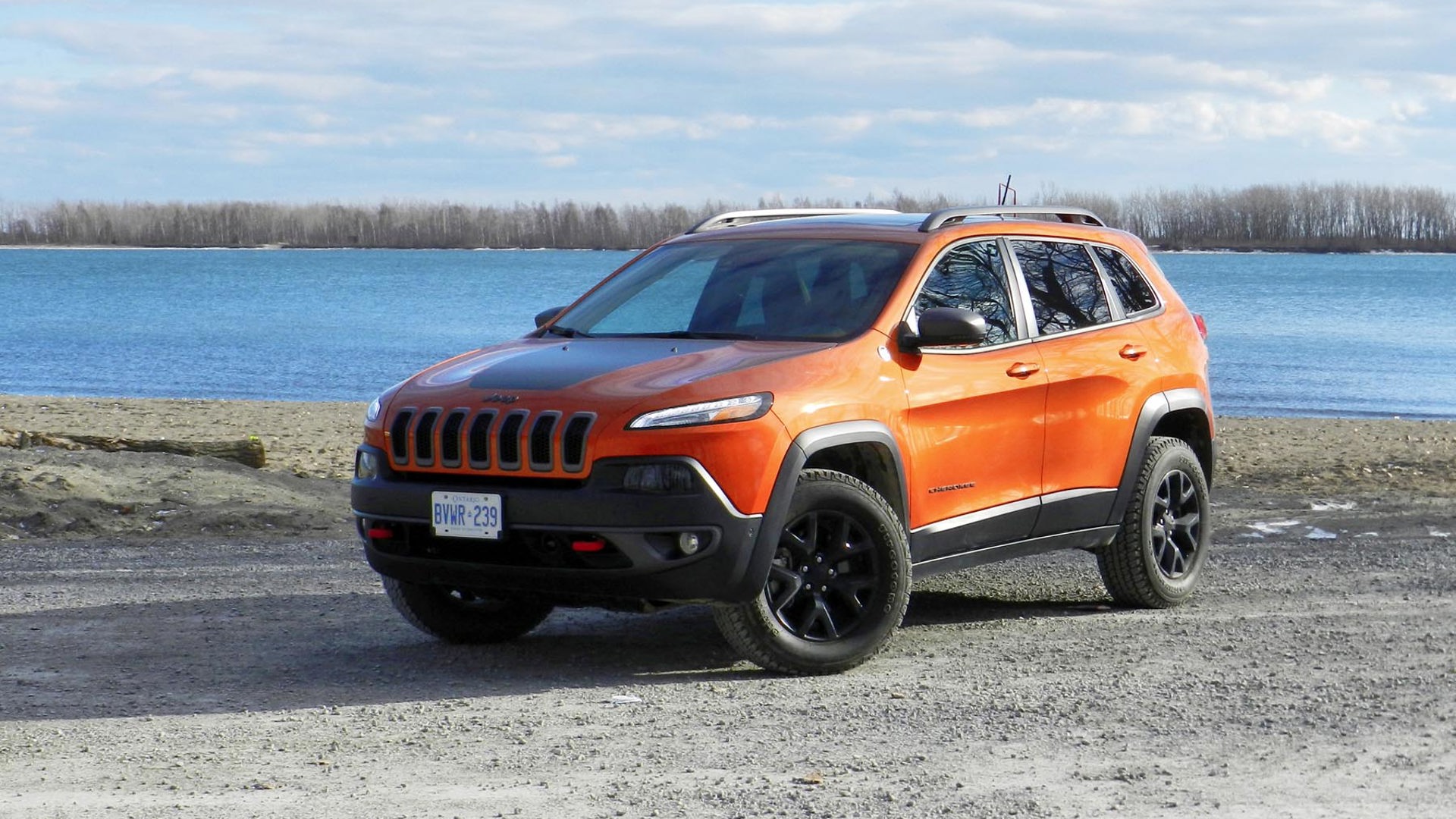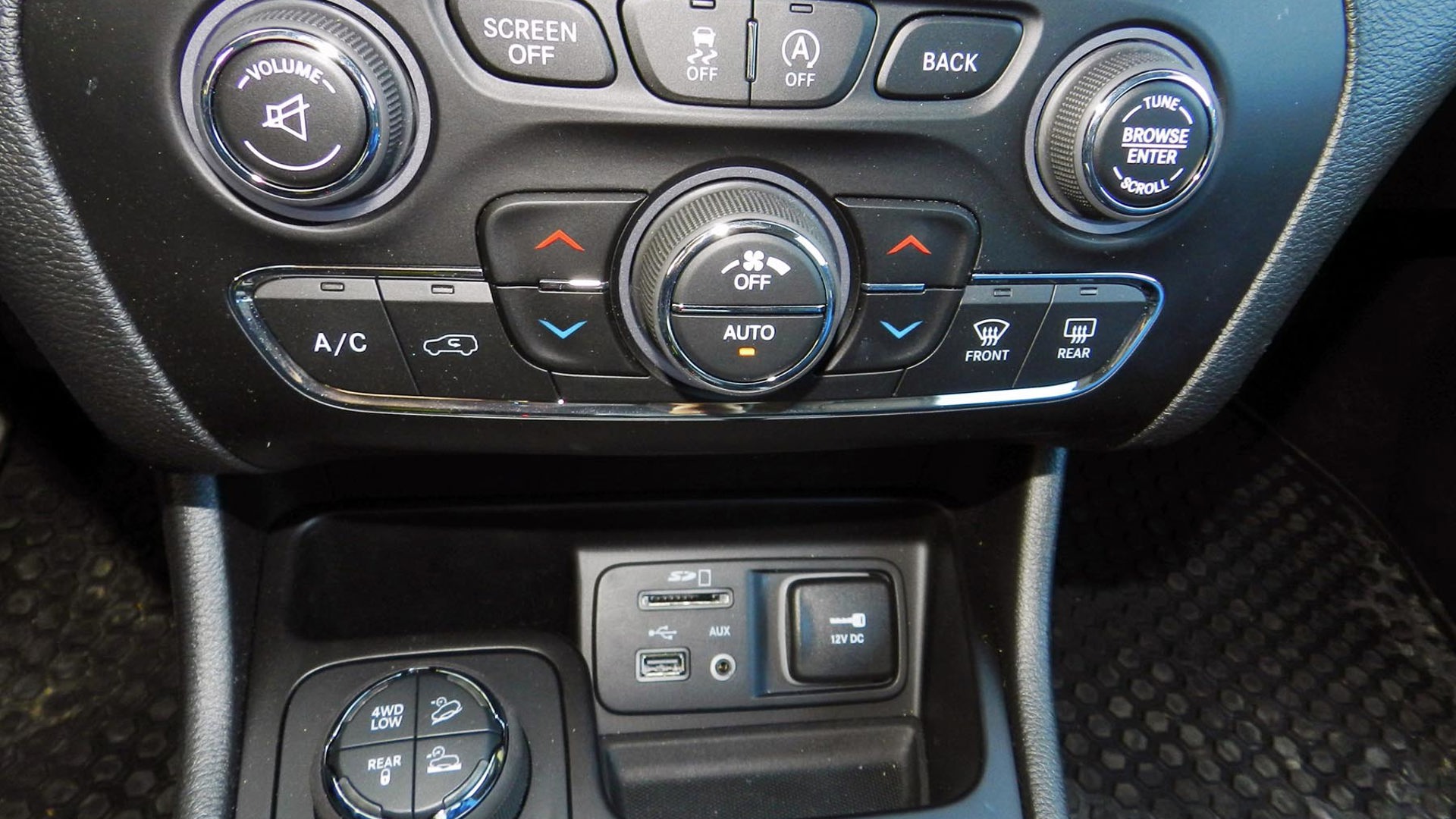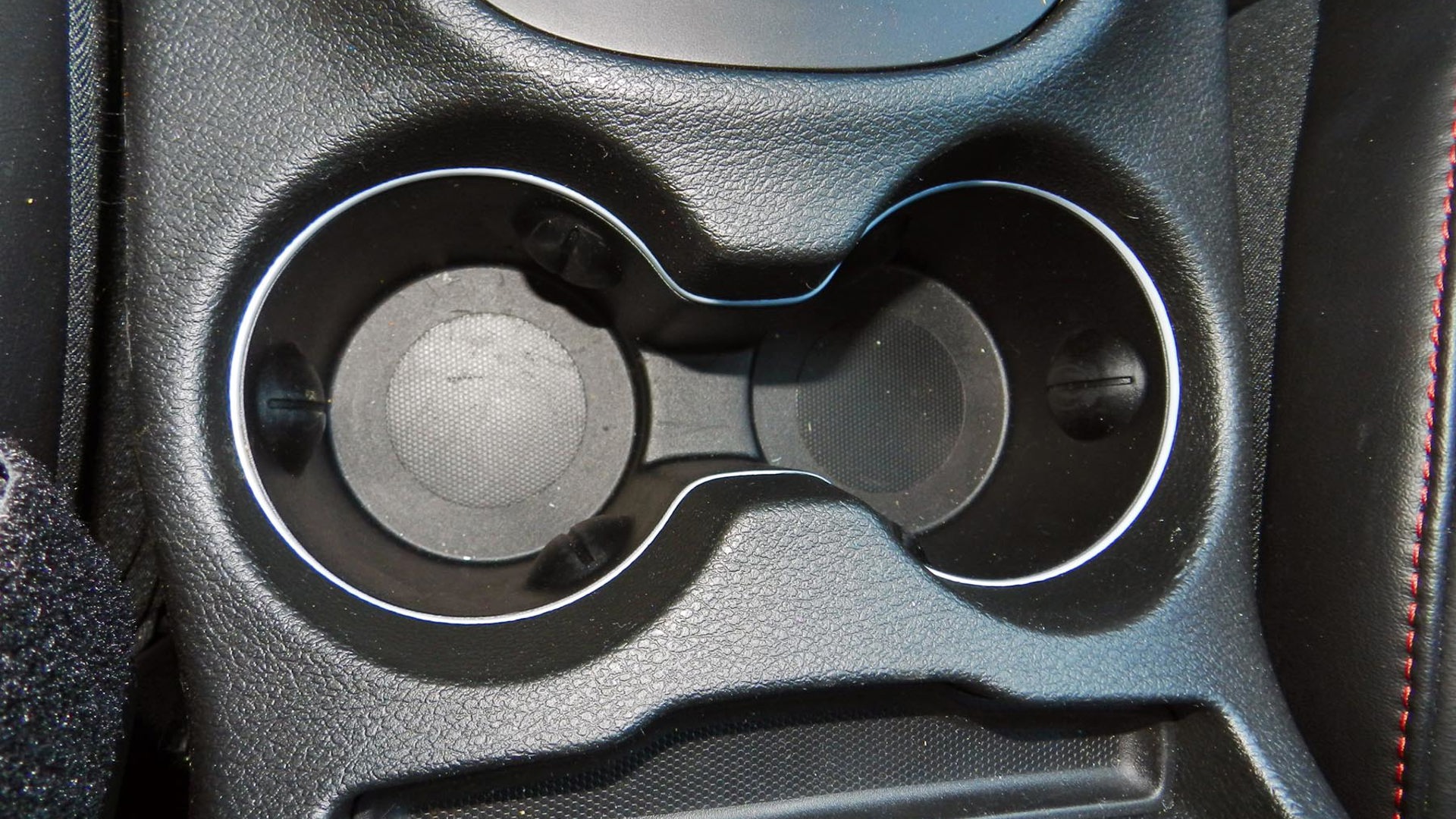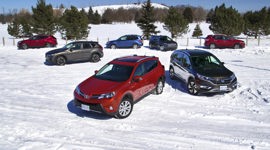 AutoTrader SCORE
AutoTrader SCORE
-
EXTERIOR STYLING8/10
-
INTERIOR8/10
-
PERFORMANCE9/10
-
COMFORT8/10
-
FUEL ECONOMY6/10
“This thing is too pretty for this,” I thought to myself. It was pre-dawn, and I’d snuck out of home to go muck about in a well-kept secret trail nestled not far from downtown Toronto. My burnt-orange chariot glistened in the early morning light, the matte black lump on the bonnet adding intrigue to the purposeful lines of the Jeep Cherokee Trailhawk. Red tow hooks protrude from under the front and rear bars, open ended so you can sling a looped snatch-strap over them. I wouldn’t be using those today even if I did get stuck. Why? Because I’d decided to go out four-wheel-driving alone.
Rule one of the four-wheel–driving guide book: Don’t go alone. Thankfully I have already had experience with the extreme capabilities of the Trailhawk and was full of confidence in its abilities. On this morning we’d only be tackling the moderate stuff – getting a feel for the automatic speed control and the ground clearance as well as the ride over rougher ground. Besides, I was walking distance from a major highway if anything did go wrong.
As long as my fail didn’t involve paraplegia or shattered limbs I’d be fine. This thing has airbags, right?
But honestly, it’s near on impossible to do anything too wrong in the Cherokee. The suite of electronic and mechanical upgrades make it a steadfast solider over pretty much any terrain. I’ve personally run now over thick mud, deep ruts, narrow creek beds, hard rock, gravel, dirt, ice, and snow and never once had the Cherokee hint at getting stuck. In properly confidence-sapping conditions I just set the crawl control and let the Cherokee creep forward at its own pace, keeping my clumsy feet well clear of the pedals and providing only gentle guidance through the steering wheel.
In terms of rock crawling, this little trail was not as intense as the one we sampled on the Jeep Cherokee first drive event back in 2013 so I had no qualms about that. What I was interested in was how this rode over rough terrain when the nut behind the wheel decided to go all wide-open-throttle on it – a test I’d not been able to conduct under the watchful eyes of the Jeep media handlers.
The Trailhawk skipped over the narrower ruts and absorbed the wider ones with ease, crashing through little mud banks with no perceptible loss of traction; there was obviously a lot of sliding and understeering, but the little Cherokee never felt like it was going to submarine or get stuck. When one particularly deep rut caught me unawares there was a loud scraping noise from the underside, but when I got out for a quick “oh crap how much will this cost me?” inspection I discovered the bash plates were barely marked. Walking back to the top of the peak I’d careened into with my undercarriage I found it had been whittled down. The Jeep it seems, is happy to reshape its environment.
On my way into a creek bed I realized why some say rigs with independent suspension aren’t real off-roaders. You simply don’t get the articulation and so there was a bit of three-wheel action going on. With electronic trickery and a well-braced chassis, though, the lack of articulation is not an issue – you still have traction to continue on your way and the chassis doesn’t suffer from carrying a wheel for a moment or two.
Bouncing along ultra-rough rutted roads my backside was well protected and supported by the leather seats – they’re cooled and heated by the way – and the suspension was well damped, settling back down to earth with little fuss. On regular tarmac the Trailhawk does drive more like a truck than a car compared to other cute utes and even next to the non-Trailhawk variants of the Cherokee, but that’s to be expected when you beef up the suspension for dirtier duty.
Want stats? From my first drive:
“In this fully off-road edition you get ground clearance of 22 cm (8.7 inches), an approach angle of 29.8 degrees and a departure angle of 32.1 degrees. Break-over angle – the angle between your tires and the underside of your vehicle which determines how sharp a rock or crest you can clamber over – is 23.3 degrees. The front suspension provides 17 cm (6.7 inches) of travel while the multi-link rear moves through 19.8 cm (7.8 inches), all this with an 11.89 m turning circle (39 feet) on the Trailhawk edition.”
A rotary dial on the console operates the Selec-Terrain system with four preset modes: Sport, Snow, Mud/Sand and Rock, which each alter the gear selection and torque split as well as the ESC response to make the most of the traction available.
The Trailhawk’s crawl control is dubbed Selec-Speed control. To operate it you press the 4WD Low button on the Selec-Terrain rotary dial and then either the descent or crawl buttons. You choose your speed in nine 0.96 km/h increments by sliding the gear selector to the left and then moving it up and down to adjust your speed. It will go as quickly as 8.65 km/h or as slow as 0.96.
Out on the road the shifter works as normal, and I was pleasantly surprised to find it set up correctly – forward for down, back for up. The nine-speed automatic transmission fitted to the 3.2L Pentastar V6 was inconsistent in its shifts, sometimes firing them off with precision and other times sluggishly. On a few occasions I experienced rough shifts (both down and up) during sedate urban driving. This is one of the least-smooth transmissions in this segment.
The V6 is a $1,595 upgrade from the base-model 2.4L four cylinder, and it’s a necessary one. The 271 hp and 239 lb-ft of torque produced by the V6 was adequate for getting up to speed but only just. With only 184 hp and 171 lb-ft of torque the four-cylinder models are frustrating to drive and also cut towing capacity from a respectable 2,041 kg (4,500 lb) to a pointless 907 kg (2,000 lb).
As an about-towner the Cherokee suffered only in fuel economy – my 13.7 L/100 km was a disappointing result. I was hoping for less especially with the assistance of automatic engine stop/start technology and the aforementioned nine-speed transmission. The EPA rates the 1,822 kg Cherokee Trailhawk at 12.4/9.0/10.7 L/100 km city/highway/combined.
Here’s another feather in the cap for the Pentastar engine – despite the greatly increased capability it is rated the same city and combined rating by the EPA, and only gives up 0.4 L/100 km on the highway to the four-cylinder. For only $1,595 extra, the V6 really is a no-brainer.
This tester was fully loaded, bringing the as-tested price to $44,430 – up from the base price of $33,390 with destination and A/C tax included. The feast of options meant everything I could possibly want was found here. The rear cargo area is officially 824 L and expands to 1,555 with the seats folded. There is Jeep’s metal cargo bar – to which I’d clamped a Jeep canvas bag full of snatch straps – and it allows a suite of shopping holders, bags and other accessories to be added. The cargo net and tonneau cover further keep things tidy and I easily fit my large suitcase, carry-on and a large backpack in the back.
The rear seats are cramped in their forward-most position, but they slide back a few inches to open up legroom for taller passengers. I slid them back when my daughter started kicking my seat….
Headroom-wise the Cherokee was ample for my in-laws, though none of them are over 5’9" so your results may vary.
All passengers and I were impressed not only by the comfort of the interior but its design too. The Uconnect system with its large screen in the centre stack and in the dash itself is an autoTRADER.ca favourite – we love its rich graphics, comprehensive suite of beautifully displayed vehicle information and ease of use thanks to redundant controls and the innovative steering-wheel mounted controls.
In Jeep Cherokee Trailhawk use, the Uconnect system gets some additional Easter eggs, like an old Willys Jeep as the vehicle icon in the navigation display and another Willys Jeep silhouette hidden in the base of the windscreen. Dozens of neat design touches give the Cherokee an engaging and adorable character. The entire Fiat-Chrysler group seems to have their head around design-based value adds in a way that no other mainstream marque – with the possible exception of BMW/Mini – has.
There are well-thought-out storage bins and a 115v outlet too. In our tester we had a host of options that turned the Cherokee into a private fortress of technology and luxury.
First and most visible was the $1,595 panoramic sunroof. The $895 SafetyTec Group added blind spot detection and power folding mirrors, the Cold Weather group added heated front seats and steering wheel for $795 and for just $900 the Technology group added forward collision warning with active braking, lane departure assistance, auto high beam, adaptive cruise with stop-and-go, parallel and perpendicular parking assist and advanced braking assist as well as supplementary indicators and courtesy lights on the side mirrors.
Comfort and Convenience costs $1,295 and included the tonneau cover, auto-dimming rear-view mirror, remote proximity entry, dual-zone climate control, power liftgate, eight-way power driver’s seat, remote start and universal garage door opener. Furthering the pampering was the $800 leather package, the $795 Ventilated/Memory seats and the $400 nine-speaker audio upgrade.
Outside the cabin the $495 Trailer Tow Group gave us the 3.517 final drive ratio, heavy duty engine cooling, a seven- and four-point wiring harness, class-three tow hitch and the Jeep Off-Road Accessory kit. $150 added the matte black hood decal and $500 the 17-inch black aluminum wheels.
Can you live without those add-ons? Almost definitely, but they do elevate the Cherokee from “nicely configured and extremely capable cute ute” to “Holy Cow what can’t this thing do?!”
It’s a feature list that few can match for less than $45K – though admittedly that’s on the steep end of the CUV pricing matrix. You could build a Ford Escape Titanium up to over $40,000 – but you’d still end up with a turbo-four instead of the V6, less off-road ability and without things like Uconnect, Selec-Terrain and Selec-Speed.
Ultimately the value of those things will change according to your personal needs, but this writer can’t think of a better-featured, equally capable car for the money. At the base $33,390 mark the Jeep Cherokee Trailhawk is a zombie apocalypse-ready off-road brute with surprising on-road manners.
Add driving aids like adaptive cruise with stop-and-go, remote engine start, lane departure assist and blind-spot detection to the mix and the Cherokee becomes the ultimate weapon for an even scarier scenario – peak-hour traffic in Winter.
| Warranty: 3 years/60,000 km; 5 years/100,000 km powertrain; 3 years/unlimited distance corrosion perforation; 5 years/100,000 km 24-hour roadside assistance |
Competitors:
Chevrolet Equinox
Ford Escape
Honda CR-V
Hyundai Tucson
Kia Sportage
Mazda CX-5
Mitsubishi Outlander
Nissan Rogue
Subaru Forester
Toyota RAV4
Volkswagen Tiguan
And if you like to escape the doldrums of urban traffic on the weekends, the Trailhawk is an enviable trail-toy with genuine go-anywhere credentials.
| Model Tested | 2015 Jeep Cherokee Trailhawk |
|---|---|
| Base Price | $31,595 |
| A/C Tax | $100 |
| Destination Fee | $1,695 |
| Price as Tested | $44,430 |
|
Optional Equipment
SafetyTec group - $895, Cold Weather group - $795, Technology group - $900, Comfort/Convenience group - $1,295, Trailer Tow group - $495, Leather Interior group - $800, Ventilated/Memory Seat group - $795, 3.2L V6 engine - $1,595, black hood decal - $150, UConnect 8.4 with GPS - $600, nine-speaker audio - $400, CD player - $225, 17-inch black aluminum wheels - $500.
|
|


